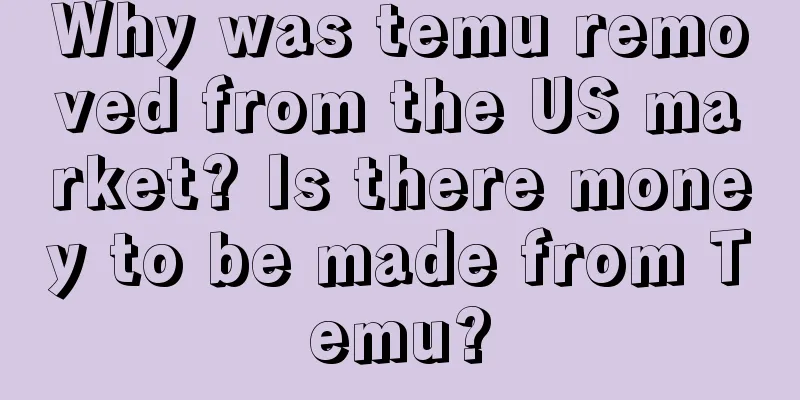Integration of brand and effect: How to achieve both popularity and sales volume, and gain both exposure and sales?

When it comes to brand marketing, especially in the field of e-commerce and digital marketing, there is a slogan that is loudly shouted: brand-effect integration . Spending one dollar to do two things, achieving a double harvest of brand promotion and sales effect, this undoubtedly hits the itch of business owners. But don't be happy yet, let me pour a basin of cold water on you first - brand-effect integration is a false concept! What this means is not that you should not pursue the unity of brand and effect in marketing, but that you should first understand what this concept advocates, its origin and its actual meaning. Only in this way can you be more likely to achieve the unity of brand and effect. 1. Analysis of brand-effect integrationBrand-effect integration comes from two terms, brand advertising and performance advertising. At the beginning of the 21st century, with the rise of the Internet, a large number of online platforms and digital media were born, and began to sell their own advertising resources to business owners in order to generate income. In order to better achieve sales and compete with traditional media for corporate marketing budgets, these digital media and their agencies (various interactive advertising companies, digital marketing companies, I collectively refer to them as ADtech companies) have jointly concocted a concept: " performance advertising ." For example, the banners, text link ads, floating ads that first appeared on web pages, the pre-roll and mid-roll ads on video sites, as well as the DSP ads, programmatic buying, information flow, etc. that were born later, can all be called performance advertising. Performance advertising is called Direct-Response Advertising in foreign countries. It is derived from Direct Mail Advertising, which means that consumers can have direct behavioral responses after watching the advertisement, such as clicking, commenting, collecting, subscribing, leaving information, and purchasing. Another definition given by Wikipedia is With Performance-Based Advertising (pay by results). Companies settle advertising fees based on the various behaviors generated by consumers after viewing the advertisement. For example, terms such as CPC, CPA, CPL, and CPS are used to evaluate the costs paid by companies for the results of consumer behavior (the above terms refer to the cost of each consumer click, action, lead retention, and purchase, respectively). Traditional media pays based on exposure and display effects, which is CPM (cost per thousand impressions) . According to this definition, the biggest advantage of performance advertising is that it is quantifiable and the results of advertising can be seen directly. Another advantage is that it is accurate and can be targeted , such as specifying the age, gender, occupation, hobbies, and brand awareness of the target audience, and targeting these specific groups; at the same time, it can also achieve different faces for different consumers, showing different advertising materials, making advertising more targeted. Since it calls itself performance advertising, in order to distinguish itself from the competition, ADtech calls the advertising activities of companies before the advent of the Internet, that is, those placed in traditional media such as television, newspapers, magazines, outdoor, and radio, " brand advertising ." This concept actually implies to business owners that traditional advertising is ineffective and can only enhance the brand, gaining only fame, reputation, brand image and other empty things, while the performance advertising they sell can bring direct and substantial sales growth. "Brand advertising" is essentially a slander against traditional media in the Internet circle. However, after so many years of development, although digital media is extremely strong, traditional media has not collapsed, especially TV and outdoor advertising are still an important part of corporate advertising, so the saying " brand and effect integration " was born. The original intention of integrating brand and effect is not that a company should have both branding and sales, but that when a company is doing marketing, it should place both brand advertising and performance advertising. But is it true that brand advertising has no effect? Of course not. If there is no effect, why do so many companies spend so much time and effort on traditional media advertising? Is it for charity? Are those companies that spend tens of millions or hundreds of millions of dollars on CCTV and Focus Media every year stupid? Brand advertising will certainly bring effects (both communication effects and sales effects), but the problem is that sales effects are difficult to measure. Because in the traditional era, communication and sales were disconnected and did not occur in the same time and space. For consumers, watching ads and buying are not continuous behaviors. They cannot be completed synchronously in time (you cannot immediately see the purchase link after the ad is played) and are not in the same place (media is media, channels are channels). I saw a laundry detergent ad on TV today. Three weeks later, when I went shopping in the supermarket, I remembered the brand and bought it. Advertisements affect sales, but it is difficult for companies to verify that my purchase behavior was influenced by an ad three weeks ago. Due to the lag in effect and the discontinuity of behavior, companies can only explore consumer psychology and measure communication effects through research, such as monitoring ad reach and ratings, and evaluating changes in brand mentions, popularity, recognition, and favorability. Alternatively, companies can compare changes in sales data after a wave of advertising cycles to determine sales effectiveness. For example, if sales and returns have increased significantly after one month of advertising, it means that the advertising is effective. But this approach can only see correlation, not causality . We cannot see how advertising actually works, and it is difficult to quantify how much advertising actually affects sales. This is the problem with traditional media. Of course, problems are problems, and you cannot use this to condemn traditional media as ineffective. On the other hand, can't performance advertising improve brands? Of course, it can, although not much. Theoretically speaking, as long as the company invests enough in advertising (no matter where), more people know about it, the product sells well, and the brand has exposure and reputation, it will inevitably produce a brand effect. Just like in the past few years, many new brands have been born on platforms such as Taobao, WeChat, Douyin, Xiaohongshu, etc., which are called Taobao brands, micro brands, Douyin brands, etc., and many of them have achieved success through the promotion and investment of influencers and effective investment. Since brand advertising has effects and performance advertising has brands, the distinction between brand advertising and performance advertising is meaningless. In particular, the "integration of brand and effect" has actually created a contradiction between brand and effect , making people mistakenly believe that branding has no effect. In order to build a good brand, one must even sacrifice short-term sales and effects, or even make a loss in branding. But in fact, the two are not contradictory. The fundamental purpose of a company's branding is to achieve better sales, and sales are more secure and sustainable when the brand power is strong. So if you ask me, brand-effect integration is a pseudo-concept and a language trap. But now it has become a common term on the lips of many companies and marketing practitioners, and has become a marketing goal. In fact, using these concepts is very harmful. It will mislead your ideas and subtly influence your thinking. When you talk about brand-effect integration more and more, you will gradually believe that you need to invest in both brand advertising and performance advertising to do communication, and you must invest in performance advertising if you want to achieve results. Don't underestimate the invented words and concepts. When you use certain words frequently, you will subconsciously agree with the logic and position behind them. The secret to controlling thoughts is to control language. In order to get back to the basics, we should reduce the use of the dichotomy between brand advertising and performance advertising, and instead use concepts such as traditional media advertising and digital media advertising, display advertising, topical advertising and promotional advertising. The difference between the two is not in the results, but only in the medium and form. In my eyes, "integration of brand and effect" does not refer to the trade-off between brand building and effect conversion, how to allocate marketing budget, how much money to spend on brand building and how much money to spend on effect delivery, which one is more and which one is less. Instead, it refers to the coordination of different media forms in communication and promotion, as well as the unity of product and brand. 2. Pros and Cons of Digital AdvertisingAs the Internet becomes the mainstream media and lifestyle, young people become Internet natives, and mobile phones become something that people cannot live without, digital media advertising and placement are becoming more and more important in corporate marketing and play an increasingly important role. Many companies have poured their budgets into digital advertising, whether they are multinational groups or start-ups. However, in recent years, many companies have begun to reflect, and the most sensational case is Adidas. In 2019, Simon Peel, global media director of Adidas, said in an interview that “ Adidas has overinvested in digital and performance media, sacrificing brand building .” Moreover, Peel also gave precise data: 77% of Adidas’ budget is spent on performance and 23% on brand [1]. In fact, many companies’ media budget allocation is basically in this ratio. In August 2022, the Adidas Supervisory Board officially announced that then-CEO Kasper Rorsted would leave in 2023, a full three years earlier than his original scheduled end of term. A dozen days before announcing his resignation, Rorsted accepted an interview with the German Handelsblatt and admitted: " We made mistakes in China ." #What exactly did Adidas do wrong in China# immediately became a hot search on Weibo, causing quite a stir in China. Throughout 2022, Anta's revenue was 53.651 billion yuan, surpassing Nike China for the first time in 30 years to take the lead. Nike followed closely behind Anta with a revenue of 51.422 billion yuan in China, and the two formed the first echelon. Li Ning ranked third with a revenue of 25.803 billion yuan during the same period, a year-on-year increase of 14.31%. Adidas China fell to fourth place, with annual revenue of only 23.597 billion yuan, a 35% drop in performance, and a 82% drop in annual profits, with revenue even less than half of Anta's [2]. What mistake did Adidas make in China? From a broader perspective, there is the brand crisis brought about by the "Xinjiang cotton incident" and the product quality and sales cost issues caused by the transfer of production lines to Vietnam. If we only talk about marketing, Adidas has several problems: a single marketing model, aging channels, and a lack of product innovation . When it comes to setting marketing goals, Adidas has strict requirements for sales. If the KPI is not achieved, the company will oversupply products and use promotional methods to increase sales. Discounts have become a normal business practice for Adidas. Although promotions can boost sales, they cannot increase profits. What is more dangerous is that they make consumers develop an expectation of discounts, become more sensitive to prices, and lose their identification and love for the brand. Therefore, it is becoming increasingly difficult for Adidas to sell at full price in China. An Adidas distributor in China once mentioned: "Since 2021, Adidas has become disorganized in its promotional rebates. Not only are the discount cycles long and the discounts large, but even the range of products covered by the discounts is very disorganized, as if it is being adjusted at any time based on inventory and sell-out conditions." [3] These problems in China are actually a microcosm of its global strategy. In 2019, Peel said that the company was too focused on return on investment and focused on short-term efficiency and performance indicators . In terms of marketing methods, Peel further explained that the method Adidas has been using in the past few years is called the "Last Click" attribution model . The principle is that no matter how many brand information and ads consumers have seen and clicked before, this model will attribute all conversions to the last click behavior before the consumer purchases. Under the guidance of this model, Adidas has spent most of its budget on SEO/SEM, information flow, and e-commerce advertising, and the advertising information is all product promotions. When it comes to brand building, Adidas has invested very little and its approach is very simple. While other sports brands are trying new marketing methods, Adidas is still focusing on signing spokespersons and shooting hard commercials. Over-reliance on discounts to clear inventory has also led to a decline in Adidas' control over channels. Last year's inventory has not been cleared yet, and this year's inventory needs to be purchased again. Such a company will naturally be overly dependent on distributors and cannot be strong in front of them. Look at Nike in recent years. It has been strengthening its digital layout, building a unified digital membership system, and learning from Lululemon to strengthen its operation and delivery of transportation groups; Anta is committed to promoting the transformation of the DTC model, achieving efficient integration of the enterprise and terminal retail, better monitoring and allocating store inventory, flexibly adjusting retail discounts, and quickly responding to consumer demand. Adidas’ 2021 financial report shows that its global distribution channels still account for 62%, while Nike’s figure is 58% (54% in Greater China), Li Ning’s has dropped below 50%, and Anta’s is just over 30%[4]. I believe the direct reason for Adidas' decline is the aging of its channels and marketing models, while the fundamental reason is the lack of innovation in its products. After implementing its fashion strategy, Adidas deviated from the mainstream direction of the sports market and relaxed its efforts in developing products in the professional sports field. It was significantly weaker than Nike in both basketball and running categories. Only its football and outdoor sports series (Adidas TERREX) received decent reviews, as can be seen from the proportion of athletes' equipment in professional competitions. Even in the field of fashion sports promoted by Adidas, it has been relying on the old Yeezy and Boost in recent years. Its products cannot keep up with the trend, but it caters to the sinking market more and more, and its clothing is becoming more and more basic. If you want to focus on fashion strategy, you have extremely high requirements for product design, brand image, understanding of social and cultural trends, and supply chain management. In addition, the quality and design of domestic brands are also catching up. Adidas is facing a strong impact in both professional technology and fashion trends. Of course, the good news is that Adidas is already recovering in 2023. On August 3 this year, Adidas released its second quarter and semi-annual financial report for 2023. Data showed that Adidas' global revenue in the second quarter was 5.343 billion euros, an increase of 0.6% over the same period last year; among them, Greater China's revenue in the second quarter was 766 million euros, a year-on-year increase of 16.4%, higher than the company's expectations [5]. So what did Adidas do right this year? First, on the operational side , Adidas' Suzhou Automated Distribution Center X, which invested RMB 1 billion, has been put into trial operation, greatly improving Adidas' supply chain and logistics response speed in China. This is Adidas' largest investment in China in the past five years. It can accommodate tens of millions of goods and has a maximum daily processing capacity of one million pieces. At the same time, Adidas also took the lead in promoting the transformation from "production determines sales" to "sales determine production" in Greater China to improve operational efficiency. On the product side , Adidas has launched a number of new products in China this year, including the global best-selling models Samba and Gazelle, as well as the CLIMACOOL series and Cool Touch series created by Adidas Asia Creative Center. In 2019, Adidas established the Asian Creative Center in Shanghai to design products specifically for Chinese consumers. The goal of setting up this center is to increase the proportion of Adidas products designed in China to 50%. At the same time, Adidas also plans to gradually increase the product autonomy of the local Chinese team. In addition, Adidas has also cooperated with many local Chinese artists and cutting-edge designers to launch new product series that incorporate more Chinese cultural customs and national elements. In early 2023, Adidas also joined hands with the five major football clubs Manchester United, Real Madrid, Bayern, Juventus, and Arsenal to launch a series of Chinese customized calligraphy clothing. (Photo source: Shuying.com) The more direct impact is on the marketing side . In the first half of this year, Adidas sponsored the Shanghai Half Marathon (the first road running event in Shanghai with more than 10,000 participants this year), the Chongli 168 Super Cross-Country Race (the largest and most influential mass participation outdoor sport in the country), the Fire Fight Street Basketball Tournament (returning after four years), and cooperated with the Chinese Track and Field Association to host the China Track and Field Street Tour. It also launched the "111 Sports Development Bureau" to promote new sports such as Frisbee and flag football. In March, adidas Originals, a subsidiary of Adidas, held three special flash events on Anfu Road in Shanghai, which received very good market feedback. The event also saw the long-lost scene of hundreds of people queuing up to buy products. In June, during Messi's China tour, Adidas hung a huge advertisement on the facade of its Sanlitun flagship store in Beijing and launched Messi-themed products, which triggered a rush of consumers to buy and long queues formed at the door on many occasions. In addition, Adidas also cooperated with the China Federation of Literary and Art Circles and the China Literature and Art Foundation to participate in the creation of the biographical documentary "Masters of the Century", and jointly carried out a series of activities to bring culture and sports to campus. These events and activities have revitalized the Adidas brand and stimulated its vitality. Bjorn Gulden, the new global CEO of Adidas, also stated in the financial report: Pursuing short-term financial results is not Adidas' goal. Adidas hopes to lay a solid foundation for future growth and longer-term profitability. Here I have interpreted in detail Adidas' several operational adjustments and performance changes in recent years. I just want to tell you that the process of achieving sales is complex and is affected by many variables , including products, pricing, packaging, channels, terminal displays and displays, brand power, advertising, promotional activities, social and cultural opinions, competitors' marketing behaviors, etc. Promotional advertisements and activities will certainly have a direct impact on sales, but don’t forget that the source of consumer purchases is their awareness and recognition of brand and product power . Even with such a strong brand power, Adidas still reflects on the excessive use of performance advertising and insufficient brand building. So how many companies are confident enough to claim that their brand power is strong enough and they don’t need to build their brand? If the brand power is obviously insufficient, but all efforts and budgets are spent on performance advertising, relying on discounts and offers to generate clicks, and relying on the lowest price on the entire network to drive conversions, then it is hard to say that this is a sustainable growth method. The achievement of results must be based on the brand. Without promotion and seeding of brand value, the conversion rate cannot be high and cannot be sustained. In the previous chapter, I talked about the huge advantages of Internet media compared to traditional media, but performance-based advertising also has its own shortcomings. First of all, performance advertising emphasizes precision and individuality, which means it cannot form a concentrated effect. In particular, programmatic buying is based on data and DMP to find precise groups of people, and then use RTB real-time bidding to deliver ads. However, this approach often results in very narrow reach and high costs. It can only reach target users, but it is difficult to create topics and volume, and it is difficult to produce brand spillover effects. In the past, when ADtech promoted the concept of precision delivery, it often quoted a famous saying in the advertising industry: " I know that half of my advertising budget is wasted, but the problem is that I don't know which half is wasted " to illustrate the value of precision delivery. But is traditional advertising really wasted? Indeed, many advertisements will be exposed to non-target user groups. Men will see sanitary napkin ads, and single people will see milk powder ads. However, the knowledge and opinions of non-target groups about the brand will also affect the decision-making of target users, especially considering that many people prefer well-known and popular brands when shopping. The goal of brand building is not only to reach the target audience, but also to make the brand influential and authoritative in the minds of the general public . Among the corporate clients I have come into contact with, one type of bosses are very superstitious about performance-based advertising, while another type does not trust performance-based advertising at all. Because if a company places outdoor or TV advertisements, you can see the advertisements as long as you pass by that place or turn on the TV at that time, but performance advertisements will most likely not be seen at all, which makes people feel uneasy and wonder where the money went. Therefore, when we helped companies place this type of advertising in the past, we would prepare a whitelist for the company’s management in advance to ensure that the company’s owners could see their own brand’s advertisements. Secondly, performance ads are mostly native ads , which imitate the platform content. That is, when you browse articles, short videos, or your friends’ circle, the ad link that appears in the content list and looks like normal content is performance ads. Therefore, the content and tone of performance ads will follow the attributes and tone of the platform content, so they are greatly limited in displaying brand image and spreading brand information . In 2013, P&G began to increase its digital media investment, investing more than one-third of its marketing expenses in online advertising and social media. P&G's then CEO A.G. Lafley said: "We need and want to be where the consumers are." [6] However, in 2017, P&G began to reflect and drastically cut its digital advertising budget, which decreased by 41% year-on-year. During the same period, Unilever also saw a sharp drop of 59%. P&G first reduced the number of websites where it placed online advertisements, and secondly, reduced its advertising expenses on Facebook, Google and YouTube. The reasons given by P&G at the time were: first, brand safety, as advertisements were often placed on inappropriate content on websites; second, P&G believed that digital media was not suitable for brand advertising because the premise for brand advertising to be effective was in-depth communication with consumers, and data showed that the effective display time of Facebook ads was only 1.7 seconds, which was not enough to effectively communicate brand information.[7] Finally, performance advertising is actually online promotional advertising in order to stimulate consumers to click and convert. However, if you only emphasize discounts, cost-effectiveness, and helping users save money, consumers will think that the brand is not valuable, which is actually a harm to brand building. Therefore, enterprises cannot rely solely on performance advertising. Although performance advertising can also bring brand exposure, its contribution to brand building is quite weak. However, performance advertising is not the only form of advertising in major digital media. Enterprises are better off cooperating with other advertising methods in communication and promotion. 3. Both brand and effectIn fact, there is no need to pursue brand-effect integration today. It can be achieved naturally. Because the integration of media and channels must bring about brand-effect integration. In the traditional era, media and channels were separated, and companies needed to do two things separately in marketing: advertising and channel promotion. First, build brand awareness in the media, and then hope that consumers will think of you and choose you when shopping at the terminal. If a lot of advertising is invested in a large area, but offline distribution cannot keep up, then the advertising is in vain, and there is no way to talk about brand effect. However, in the Internet age, media and channels are integrated together. Many platforms have both communication attributes and channel sales functions. For example, Douyin has Douyin stores, Xiaohongshu has Xiaohongshu Mall, Taobao has Taobao Live, and WeChat has content products such as official accounts and video accounts, as well as private domain management methods such as WeChat groups, mini-program e-commerce, and Weidian. Many brands use Douyin to create content and embed products with influencers. Product links are placed in the videos to promote sales. At the same time, the brand will design a unified topic tag and package a large number of video contents. This topic tag will become a distinct brand theme, deepen consumer memory and cognition, and become an important brand asset. The soda wine brand Kongka has done a particularly good job in this regard. So is this a combination of brand and effect? Top anchors like Li Jiaqi can not only help companies sell goods, but also increase the popularity and recognition of corporate brands. "Li Jiaqi's recommendation" also provides credit endorsement for brands, and in fact plays the role of brand spokesperson. So is this a combination of brand and effect? For example, the live broadcast room of the Coco Tree brand has a lot of live broadcasts of beauties and macho men. Live broadcasting is originally a sales behavior, but Coco Tree's practice has created topics and formed heated discussions, which objectively increased the popularity and voice of the brand. So is this a combination of brand and effect? Even in today's media, when companies place advertisements in elevators, subways, bus shelters, etc., they will put a brand QR code in the advertisement screen. After watching the advertisement, users can scan the code to directly enter the online store to place an order, scan the code to receive free coupons and red envelopes, add customers on WeChat for details, and make appointments to participate in brand activities. So is this a combination of brand and effect? There is a women's clothing brand called Zhong Weiwei. It has placed a lot of elevator ads in the past few years. The purpose of the ads is to guide consumers to scan the code and add the brand's personal WeChat account, and then sell goods through private domains. This practice turns the recognized traditional hard advertising into private domain operations. Zhong Weiwei also teaches others online how to improve the conversion effect of advertising. So is this a combination of brand and effect? Therefore, the integration of product and effect is natural. However, if enterprises want to achieve this better, they need to unify product and brand management, integrate communication and promotion, and coordinate different media forms and means to form a link. 1. Integration of communication and promotionSince there are so many media platforms and channels today, enterprises must make good choices and trade-offs when implementing communication and promotion. Communication cannot be egalitarian, resources and expenses are dispersed, and the effect will be poor. Enterprises need to find their own main battlefield, concentrate superior forces to penetrate the core media platform, and implement focus and blasting. This focus should be on both media selection and dissemination content. When communicating, companies should extract clear and powerful core concepts, and then build a unified and distinctive theme based on the concepts, set the main communication topic, speak with one voice on various media platforms, tell one thing well, and allow users to form a consistent cognition and impression. In the age of information explosion, only in this way can we break through consumers' information filtering mechanism and penetrate into users' minds; only in this way can we break through the information barriers between different media platforms, establish cross-media connections, and create a synergy in communication. On the other hand, when companies are doing communication, it is also necessary to plan and design the consumer's behavior flow, form a communication link, and guide users step by step to complete the whole process from paying attention to the brand, recognizing the brand to completing the purchase and establishing a relationship. Because the properties and functions of different media platforms are different, such as Douyin and Weibo are suitable for brand exposure and topic implantation, WeChat is suitable for in-depth communication and private domain management, Xiaohongshu and Zhihu are suitable for product promotion and knowledge sharing, so when companies use these platforms for communication, they should make them cooperate well and perform their respective duties. Moreover, even if a company only focuses on a certain platform, there are often various advertising forms and promotion tools within the platform, and these different means must be used in coordination and well-linked. Today, many media platforms are promoting their own communication links, allowing companies to implement communication and promotion according to these links. For example, Weibo’s communication link is called “4L”, which divides the brand’s marketing path into four steps: L1 social detonation (Launch), L2 mental penetration (Like), L3 user connection (Link), and L4 brand advocacy (Loyalty). Marketing on Weibo follows this procedure: first, create topics to attract consumers' attention and discussion, then penetrate consumers' minds and strengthen their cognition through a large amount of content and blog posts, and then guide users to participate in brand activities, make purchases, and follow brand accounts to become long-term fans. Around this step, Weibo provides advertising products including boot headers, hot search topics, search keywords, KOL content cooperation, etc. Brands can also manage their own brand accounts, which have exclusive styles, brand moments, brand friends, profile pages, and fan groups. For example, Douyin’s consumer link is “5A”: A1 Aware, A2 Appeal, A3 Ask, A4 Act, and A5 Advocate. Brands need to guide A1, A2 and other users to develop towards A4, A5 and other directions. To achieve this link, the available advertising formats in Douyin include splash screen and Topview, bidding information flow, sticker ads, search ads, expert content cooperation, platform content IP and challenge activities, as well as brand accounts and live broadcast rooms opened by companies themselves. Promotion is not like piling up resources or doing everything at once, but it requires careful planning, logic, sequence and coordination. Let's take a look at a case. In July this year, Sprite launched a new product, "Tribute to 1982 Limited Lemon Flavored Soda", which was sold on major domestic e-commerce platforms, supermarkets, convenience stores and catering channels. The inspiration for this product comes from the old internet meme "Sprite of 1982", which is a variation of "Lafite of 1982". Its original meaning was to express being rich and luxurious, but it was later used for self-mockery in the internet context, giving rise to a variety of jokes and emoticons. The promotion of the product Sprite was entirely centered around the theme of "Bring a bottle of 1982-year-old Sprite." Douyin and Weibo were chosen as the main platforms. Two communication topics were created on Douyin: #Bring a bottle of 1982-year-old Sprite has actually come true#, and on Weibo: #Can a bottle of Sprite be auctioned?#, to attract netizens to pay attention to the brand and participate in discussions. (Photo source: Knife Skills Research Institute) Immediately afterwards, on July 5, Sprite created a major event, "Sprite Tribute to 1982 World's First Auction", to take on the traffic brought by the topic and conduct live broadcast sales. At the auction, Sprite played with the meme to the end, inviting Wang Yaoqing, a celebrity spokesperson who often plays the role of "domineering president", to serve as the chief tasting officer, and unboxed the "1982 Sprite" with a sense of ceremony. Five sets of luxury gift boxes were launched for auction, which included a series of exclusive customized services, such as a visit to the Lafite Asia brewing base, which fully demonstrated the sense of ritual and dignity teased by the "Sprite of 1982". The auction event itself created more topics and content materials, continuing the popularity of brand topics. With the topics and major events, Sprite used two methods on Douyin: “Easter eggs in the comment area” and “small blue words” to guide users to search, comment, and click, directing users to product pages and achieving sales conversion[8]. In addition to online traffic, Sprite also placed large-screen advertisements in core business districts such as Hangzhou Gonglian CC, and placed materials in offline product counters to remind users to buy and implement marketing. Sprite's approach can be said to be a typical implementation of communication and promotion today, with focused media platforms, unified communication topics, and clear promotion links. It has a core main position, and uses unified themes and topics to connect different platforms, gather traffic for each content, and form a highly concerned social topic; then use live broadcasts of major events to carry traffic, detonate sales, and continue the popularity; and then achieve conversion through various specific online and offline means of diversion. Another example is the launch of Xiaomi Mi 9. On February 20, 2019, Xiaomi released the Mi 9 mobile phone. One of its selling points is the holographic colorful curved body design. When exposed to light, the body will show rainbow colors and mermaid lines. It is very beautiful and was known as "the best-looking Xiaomi mobile phone so far" at the time. The world's first Qualcomm Snapdragon 855 processor, the first use of rear triple cameras, moon mode, 960fps slow motion and motion tracking, and the fifth-generation Corning Gorilla Glass, etc. Based on these selling points, Xiaomi has refined an advertising slogan for it: " Good-looking and powerful ." At the same time, the code name of this mobile phone within Xiaomi was "Battle Angel". At that time, the film "Alita: Battle Angel", which took 20 years to create by the famous Hollywood director James Cameron, was released. So Xiaomi reached a cooperation with the film and became its exclusive mobile phone partner, strengthening the product " Battle Angel " label. In the early stage of product launch, Xiaomi Mi 9 mainly used Xiaomi's own new media resources, spokesperson Wang Yuan's resources and the popularity of the movie "Alita" to warm up and build momentum for the product. At that time, Xiaomi did the following things. First of all , Lei Jun, known as "Xiaomi's No. 1 digital blogger", led the Xiaomi executive team to speak out collectively, releasing various details and inside information of Xiaomi 9 in multiple Weibo posts a day, arousing users' interest and attention. Then , various news about Wang Yuan were continuously announced, such as attending the launch of Xiaomi 9 and launching a customized mobile phone case for Wang Yuan. At the product launch, Wang Yuan also took a selfie with Lei Jun, making full use of his spokesperson resources. Later , on Weibo, Lei Jun also released three viral videos of his interaction with Wang Yuan, showing the product's selling points through question-and-answer chats and holding lucky draws for forwarding. On WeChat, Xiaomi 9 put up a Moments ad when it was launched, in the form of "Lei Jun airborne Moments", publishing content of Lei Jun and Wang Yuan answering Proust's Questionnaire together, which fully utilized the personal charm of the two celebrity IPs while weakening the commercial attributes, attracting a lot of attention and discussion. 4) In collaboration with "Alita", Xiaomi launched a limited edition mobile phone case, the Xiaomi 9 transparent exclusive version. The product adopts a mecha-style design, and the transparent back cover reveals the internal components, which is full of technological atmosphere. Xiaomi also designed the main lens of the mobile phone into a holographic fantasy angel eye. After the product was officially launched, Xiaomi built the entire launch communication around the two major labels of "Battle Angel" and "Good-looking and powerful", and placed a large number of media advertisements, leaving a unified and deep impression on consumers. In the Xiaomi 9 advertising MV "Will You" starring Wang Yuan, Wang Yuan and Xiaomi 9 walked out of the black and white stage together. As Wang Yuan punched the camera, the picture also turned into gorgeous colors, highlighting the core communication information of "good-looking and able to fight". In various advertising posters, there are a large number of copywritings such as "good-looking and able to fight", "fighting for you", "mecha warrior" to strengthen user awareness; in the various grass and evaluation content of Xiaomi 9, these labels are also highlighted, emphasizing that Xiaomi 9 is a good-looking and able to fight combat angel mobile phone. On TikTok, Xiaomi launched the challenge #Million Find Battle Angels”, inviting users to upload their talent videos and share millions of bonuses. The video can be shot by yourself or used by Lei Jun/Wang Yuan’s materials for co-shooting. This approach not only lowers the threshold for participation, but also has fun and strong interaction, expands the influence of the event. At the same time, Xiaomi also invited many vertical experts from beauty, appearance, funny plot, sports and fitness, special effects technology, etc. to cooperate. These experts have both good-looking appearance and super talent. They have created a large number of content videos and put a unified topic tag, deepening the labels of Xiaomi 9’s “battle angel” and “good and good-looking”, allowing the brand to gain a lot of exposure and deep understanding. The total number of views of this event reached 2.24 billion times, and Wang Yuan's endorsement and the use of the Douyin platform made the proportion of female users participating in the challenge reach 62.8%. In the past, 70% of the users of Mi fans were men. This series of promotions helped Xiaomi expand the female user group [9]. Xiaomi 9's promotion was very successful. Not only was the product well received, but it also showed a grand occasion of being hard to find. As of September 2019, its global shipment reached 4.7 million units. As Xiaomi's last cost-effective model, Xiaomi phones then officially embarked on the road to high-end development. The achievement of product-effectiveness integration requires companies to cooperate in many events. For example, on the one hand, we must launch hard marketing and content planting, output product information, and improve product exposure and awareness. At the same time, we must create topics and events to enhance brand image and popularity, and create an atmosphere of popular and popular sales in the brand. On the other hand, enterprises must also do a good job in distribution and channel construction, cooperate online and offline, and may also need to do some promotional advertising and activities. In this way, the voice and sales can be as good as the exposure and selling, and the fish and bear's paw can have both. However, with the cooperation of various tools and means in communication and promotion, what is more important is the unity of products and brands. 2. Unification of products and brands In the lecture "The Contradictory between Brand and Product", I talked about the relationship between brands and products. Brand and products should be one, but the two are often disconnected in the actual operation of the company. When many companies talk about product sales, they are very hard and practical, selling points, promotions, and price wars, and at the brand level, they have become a fake image, culture, and values. When selling goods, they emphasize cost-effectiveness, annual promotions, and the lowest price on the entire network. In terms of brand building, they are eager to create high-end and establish a high-end image. This is called schizophrenia. It is difficult to achieve the integration of product and effect, and the sales effect is difficult to last. Products and brands must be unified. When promoting brands, companies should use products as carriers and use products to undertake brand information. Just like the Sprite mentioned above. Sprite uses a new product as a carrier to carry the traffic of the topic "Sprite in 1982", and then drives the increase in brand voice and activation of brand image through product promotion and sales. Because this product has its own topics and memory points and its own brand attributes, it also achieves the purpose of brand communication while achieving sales. The same is true for the Baixiang Coriander Noodle mentioned in our previous lecture. Sprite's product has two versions: glass bottle and PET bottle. Both are sold for limited time, and glass bottles are even more limited. During the launch period, the glass bottle products were sold out in two days after they were launched, with more than 120,000 bottles sold. 600 sets of limited edition gift boxes during the auction live broadcast were also sold out on the same day. Moreover, the number of people online in the auction in real time exceeded 100,000, with a total number of viewers exceeding 3.8 million. The Sprite brand’s related topics were exposed on the entire network by more than 540 million, making it popular all over the Internet and becoming the top star in the beverage industry [10]. This is the double harvest of brand and sales. Similarly, when developing products, enterprises should also consciously inject differentiated functional benefits and design styles into them, and they should be able to reflect the uniqueness of the brand and reflect the brand value and concepts, so that consumers can simultaneously feel the charm of the brand when purchasing products. If the company's products are ordinary, completely homogeneous, and win purely by price, it will be difficult to achieve brand asset accumulation. When promoting products, companies must also strengthen brand communication and output brand core values and brand stories. Use brands to endorse products, so that consumers can feel the brand through products, and the two achieve each other. In 2019, there was a newly established high-end seasoning brand in China, "Song Fresh", which focuses on healthy, natural and zero-addition plant seasoning products. The core product is Matsutake seasoning. Other main products include Matsutake Yipin Fresh, Matsutake vinaigrette, etc. After more than a year of establishment, Matsutake sales exceeded 60 million. Songxianxian’s main promotion method was to do live broadcasts. It first landed in Weiya’s live broadcast room in April 2021, and sold 160,000 bags of seasonings at one time, with sales reaching 1.1 million. After tasting the sweetness, Songxianxian participated in Weiya’s live broadcasts six times, an average of once a month, and the amount of goods sold reached one million, which not only drove sales, but also improved brand awareness and recognition to a certain extent. (Photo source: Radar Finance) However, live broadcasts also have their own problems. In order to get the live broadcast contract, Songxianxian gave the lowest price on the entire network , and also paid a pit fee of 50,000 yuan and a sales commission of 20% in each live broadcast [11]. However, it would be fine if it could be sold. Song Xianxian also found many other anchors and celebrities to sell goods, and invested pit fees ranging from tens of thousands to hundreds of thousands of yuan, but they could not even recover the cost. They even had a painful experience of paying 30,000 yuan in pit fees for only 1,000 yuan [12]. According to Song Xianxian founder Yi Zihan, the founder of Song Xianxian, the expenses of various live broadcast cooperation in 2021 were not recovered by more than 2 million [13]. On the other hand, as a high-end seasoning brand, the core group of Songxian is middle-class families and exquisite mothers. Among consumers , the proportion of 30-50 years old is more than 50% . Families with children pay more attention to reducing their intake of salt, sugar and chicken essence. However, after analyzing Weiya's sales data, she found that her fan portraits were very broad, which was inconsistent with the middle-class customer base that the brand wanted to capture. Although the live broadcast brought goods, it did not achieve the purpose of building a brand. What’s worse is that the newly introduced traffic disrupted Song Xianxian’s original fan portrait. According to Tmall’s algorithm, the overall natural traffic of the store finally dropped by 30% year-on-year . Yi Zihan said, “This is definitely a major mistake for our entire Tmall team.”[14] In addition, Songxianxian encountered a black swan incident on the live broadcast. On December 20, 2021, Songxianxian was originally scheduled to participate in Viya's live broadcast for the 8th time, and prepared goods worth millions of yuan a week in advance. However, Viya's sudden blockade caused 120,000 bottles of soy sauce to be backlogged in the warehouse, while the soy sauce with zero addition was only six months, and it was difficult to digest the own channels, so it was too late to find new channels to ship. At that time, Song Xianxian had to post a public account for help, and received reposts and spread from many users. It took only one day to clear the inventory . The key to Songxianxian can do this lies in its successful private domain operation. Among Songxianxian’s sales exceeding 100 million yuan in the past two years, the online proportion has reached 90% , focusing on channels such as Tmall, Douyin, private domain and social group buying. Among them, Tmall’s unit price is 80 yuan, with a repurchase rate of 50%, while private domain customer orders are as high as 150 yuan, and repurchase can be achieved by 300% . At present, Songxianxian has accumulated more than 1 million private domain fans throughout the entire network [16]. The outstanding performance of private domains is due to the strengthening of brand awareness. Song Xianxian emphasizes the dissemination of brand stories, the output of corporate values and the creation of founder IP. For example, the output of values. Song Xianxian has always emphasized the following points in its external communication: First, user cognitive education, emphasizing product information such as 0 additions, healthy seasoning, healthier and more nutritious than chicken essence, MSG; The second is to take advantage of the super ingredient of Matsutake to improve the brand status and value, and emphasize the brand awareness of the pioneer of Matsutake seasoning; The third is to focus on the core groups, bind children, the elderly, and pregnant women, promote maternal and child nutrition, and the baby loves to eat, the whole family can eat with confidence, etc. (Picture source: Songxianxian official Weibo) Songxian has made a lot of content output around these keywords and brand values. It has created 3 public accounts: teaching vegetarian food, Qingxin Lake Vegetarian food, Qingxin Lake Vegetarian food [17], and through the matrix of official account + video account, it outputs the concept and specific methods of healthy eating. At the same time, Songxian also uses a large number of KOLs and media in the food field to expand brand communication. During the annual Matsutake Season, Songxian also held a Matsutake River Trail Season event, inviting mothers to witness the natural and quality journey together. The theme of its event is called "Mom, please rest assured". On Mother's Day, Songxian also created a promotional event of "I am not a mother today". For example, the output of the brand story and the founder IP. Song Xianxian has created the core account "Yi Zihan Talks the Ingredients List", which operates on platforms such as video accounts and Douyin, and has also tried to open a large number of accounts, such as nutritionist mother Yi Zihan, Song Xianxian founder Yi Zihan, Yi Zihan Talks about emotions, Yi Zihan Talks about education, Yi Zihan Talks about entrepreneurship, etc. In these accounts, they emphasize Yi Zihan's identity tags such as grassroots entrepreneurs, public nutritionists, and mothers, and output their entrepreneurial stories, including 12 years of experience in R&D of healthy food and 4 years of experience in Indian yoga practice. In addition to self-media operations, Songxian is also reaching various channels of consumers, such as the product page of Tmall flagship store, continuously outputting the founder IP, presenting it in a unified manner, and displaying it repeatedly. This approach not only establishes a character design, narrows the distance between the brand and the user, and establishes a sense of favorability and closeness; it also gives the brand a story, transforming recognition of people into trust and support for the product. Character design and story can deepen the user's impression than product function promotion, improve users' sense of identity and repurchase willingness. Through Songxianxian’s story, we can see that corporate marketing cannot only emphasize selling goods and promoting product functions, and the output of corporate values, product concepts, and brand concepts can also bring better sales returns. At present, Songxianxian’s main channel is online. Because offline channels have long been monopolized by traditional condiment giants, new brands rely on online platforms to open up a gap. Data shows that Songxianxian currently has only more than one point in offline channels , while online is much higher than this, and Douyin channel can reach 10 points [18]. Therefore, in the early stage of entrepreneurship, Songxianxian is more cautious about entering offline channels and actively invites them to do not settle in without channels. However, offline is the basic market for condiments after all, and consumers are more accustomed to buying condiments offline. With the growth of operating performance, Songxianxian will inevitably focus on offline. In 2021, Songxianxian has been sold into 2,000 supermarkets in East China and Central China, and its annual goal in 2022 is to sell 10,000 supermarkets across the country [19]. On the other hand, from the perspective of product line, Songxian’s current main product is Matsutake seasoning, with single product sales accounting for 50% , while Matsutake seasoning, Matsutake vinegar sauce and Matsutake Yipinxian account for 85% [20]. To further expand, the focus of the product must shift to products such as soy sauce, expand the product line and SKU. In this way, Songxian will face the leading brands of chicken essence such as Taitai Le and Jiale, as well as flavor giants such as Haitian and Qianhe. It can be foreseen that Songxian’s large-scale brand promotion and outdoor and elevator advertising may arrive soon. In product sales, brand power is an important factor affecting consumer decision-making. Product promotion should be consciously integrated into the brand, which can reduce marketing costs, increase conversion rates and form long-term repurchase. The strength of brand power lies in the product sales volume and the opportunities and frequency of the product appearing in consumers' lives. Brands and products must be unified, and they cannot be worn. This is the fundamental guarantee for the integration of product and effect. In this article, we have analyzed the concept of product-effectiveness integration, analyzed the advantages and disadvantages of digital media and digital advertising, and put forward two fundamental suggestions on how to achieve product-effectiveness integration. I hope this article can help you further achieve product-effectiveness integration. Notes to this article: [1] "Lessons learned by Adidas spent 3 billion to buy: Why is it so difficult to build a brand?", Source: Official account "System 2 Brand Consulting", Author: Li Yi, 2019-10-30; [2] "The performance appraisal of the four major domestic sports brands in 2022: mixed joys and sorrows", source: Sina Finance, 2023-03-28; [3] "Say goodbye to negative growth for eight consecutive quarters, Adidas's China business is still difficult to turn over", source: Dudong Finance, 2023-08-10; [4] "What is Adidas wrong in the Chinese market?", source: "Finance" magazine, 2022-08-24; [5] "Adidas China, From Recovery to Growth", Source: Consumption Titanium, 2023-08-04; [6] "35% of the proportion: Procter & Gamble accelerates investment in digital media", source: Modern Advertising Magazine, 2013-08-07; [7] "Invest US$7.1 billion a year, cut 200 million budget for 10% to increase, how did Procter & Gamble use money to change the advertising industry? | Morketing Deep Articles", source: Morketing, author: Neo, 2018-03-06 [8][10] "Shiseido Topic 250 million reads Sprite sold out in 1982丨E-commerce "Super Product Daily" Monthly Report", source: Yibang Power, 2023-08-09; [9] Toutiao Yi "Perpendicular Screen: Hard-core Methodology for Integrating Product Effects in Short Video Marketing", Publisher: Machinery Industry Press, 2020-1; [11] "The former assistant broadcasting became the first place in the "sales list": Attacking Douyin and making tens of millions of dollars", source: WeChat public account "Operation Research Society", author: Operation Society Editorial Department, 2022-05-18; [12] "Kuaishou does not need a top anchor", source: WeChat public account "Yishi Business", author: Li Buxu, 2022-01-27; [13] "After Via, another "big boss anchor" has an accident", source: WeChat public account "Pencil Road", author: Han Xiyan, 2021-12-29; [14] "Via collapses, experts live broadcasts to reduce fever, don't deify e-commerce live broadcasts | Shenkr lite", source: 36Kr, author: Liu Danru, 2022-01-22; [15] [19] "Dialogue with Pine Fresh: Reduce salt with left hand, reduce sugar with right hand | New seasoning", source: FoodTalks Food Information, 2022-01-17; [16][20] "Matsutake Seasoning Replaces Chicken Essence and Salt? "Pine Fresh" Want to Provide Consumers with Healthy, Zero Additive Seasoning Products", Source: 36Kr, Author: Zhudy, 2021-11-05; [17] "11,000 words, 11 CEOs, detailed analysis of brand growth across the region", source: public account "Marketing Lao Wang", 2022-05-07; [18] "0 additive soy sauce collectively out of stock: After Haitian's market value evaporated by 30 billion | Focus Analysis", Source: 36Kr, Author: Yang Yafei, 2022-10-18; Author: Empty-handed Source: WeChat official account: "Empty Hand" |
Recommend
144-hour visa-free policy has made overseas travel bloggers popular
This article explores how the visa-free policy can...
Flying towards the future, meeting new potential - Feilaihui appeared at the 2024 APEC SME Cross-border E-commerce Summit
On March 26, as an ecological partner of DHgate.co...
Young people love to watch and brands love to invest in farming variety shows: 4 inspirations for marketers
The author of this article talks about the marketi...
How to check the logistics of eBay? What are the methods?
With the rapid development of e-commerce platforms...
Can Shopee be deregistered and reopened? Why was it shut down?
When everyone first joined the Shopee platform, th...
How to cancel Amazon joint account? What are the methods?
If you want to open a store on Amazon, you can lea...
"Counterattack" Uniqlo, with more than 10 million private domain users, how does the most popular domestic fast fashion brand layout its private domain?
This article focuses on the local fast fashion bra...
Death of an Algorithm Engineer
In the wave of digital transformation, algorithm e...
From brewing tea around the fire to iced tea, who has made a fortune from this cup of tea?
Recently, young people have come up with new ways ...
A guide to using Xiaohongshu’s new platform “Chengfeng”
Xiaohongshu launched a new platform "Chengfen...
List of 182 popular titles on Xiaohongshu.
Want to create popular content on Xiaohongshu? The...
Can I be arrested if I only collect payment but do not deliver the goods in foreign trade? How do I collect payment in foreign trade?
With the acceleration of globalization and the boo...
How many points will be deducted from Shopee before the account is frozen? What actions on Shopee will cause points to be deducted?
When opening a store on an e-commerce platform, me...
Where and how to view Amazon's organic traffic?
Amazon merchants should pay attention to the store...
Brand Marketing Guide
What aspects should be taken into consideration to...









